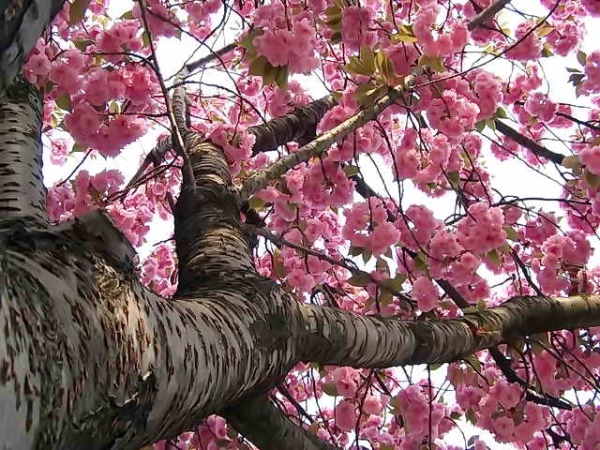The forms of East-Asian species of small-cherished cherry with double flowers are known under the generic name "Sakura" or Japanese cherry. Japan is considered the habitat of distribution and the birthplace of exotic plants.
Table of contents
The difference of Japanese cherry from other varieties
The trees belong to the family of pinkare fast-growing and reach a natural height of 20 meters. Modern selection has about 400 varietal variants.
The cultivation of garden varieties is based on grafting and crossing cultivated species with spicy serrated wild cherry.
Sakura characteristic sprawling rounded crown. Its bark has a brownish-red color and is covered with a network of small cracks.
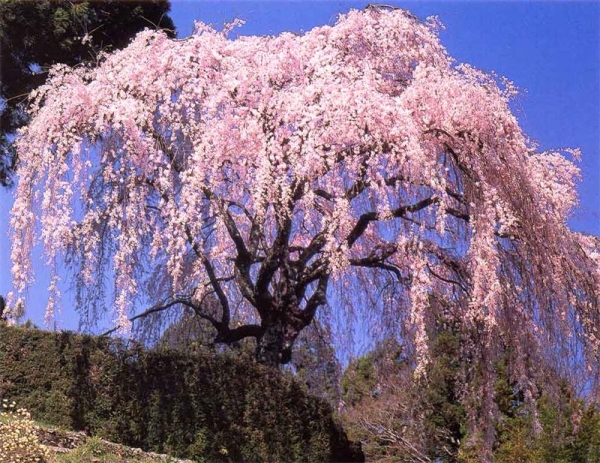
Oval sheet plates with notches around the circumference in the autumn change color in the range from dark crimson to brown. Fruits are not suitable for ingestion.therefore cherry-sakura is considered to be an ornamental plant.
Planetary fame East Asian cherries have won a colorful flowering. Petals have shades of white and pink tonality. There are species with yellow, red and raspberry tassels.
The value of plants for the holiday of Hanami
According to one of the versions, in a reddish tint, sakura petals were stained with blood of family members of one of the village elders.
After he showed the ruler the scars on the backs of his children because of the cruel treatment of the prince's servants,the last of them had been torn to death on the top of the mountain where the sakura grew.
Fallen petals turned pink from bloody stains. Now they symbolize the fragility of children's destinies in the modern world.
The celebration of Hanami is symbolically carried out by the family atmosphere. The duration of the process depends on the flowering period of the legendary cherry.
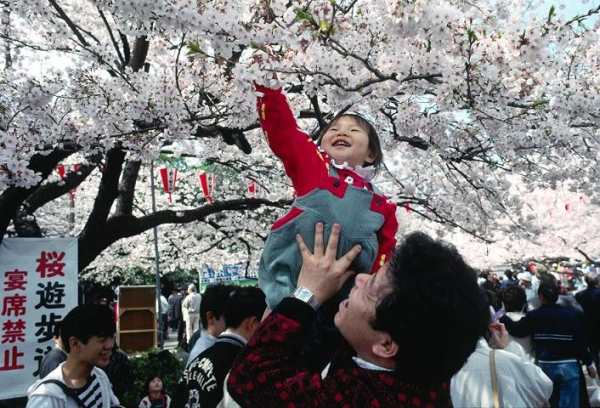
Each of the trees blooms for several days.: sooner or later - depending on the species. As a result, a chain is formed - the flowering plants pass the baton to dissolving.
Japanese mass media notify the residents in advance of the estimated time for the cherry blossoms to bloom and its duration: many people prefer to travel around the country to repeatedly catch a grandiose spectacle.
Traditionally Hanami falls on the end of March or the beginning of April.
Main varieties
Kiku Shidare
The most suitable variety of garden melkopilchataya cherry for steppe and forest-steppe zones with moderate continental climatic conditions. Healthy trees grow to the level of 4 m, with an annual increase of about 30 cm.
Crohn in plants Kiku Shidare spreading and prone to thickening. The sheet plates have an elliptical shape with small, often notched barbs and a relatively large size (7–9 cm).
The decorative feature of kik shidare is enclosed in the early prolonged flowering period (the outcome of March is the first decade of April). Brushes of large-diameter (5-7 cm), densely-double pink flowers are numerous and abundantly cover the branches.
Self-fruited variety. A single-planted tree with qualified care intensively blooms and bears fruit.
For growth prefers sunny areas on sandy-clay, alkaline or neutral soils. The abundance of flowering depends on the regularity and timeliness of fertilizing with superphosphates.
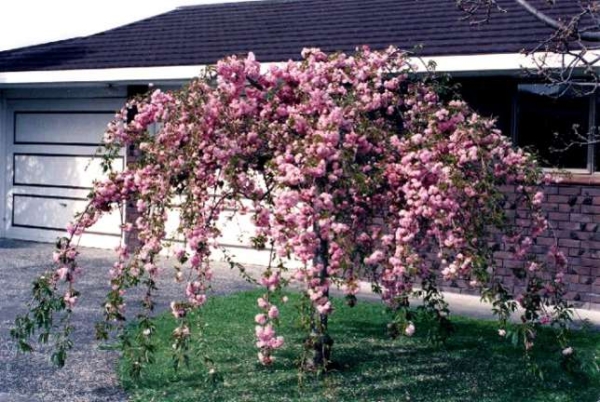
Kansan
This small-stalked tree species of garden sakura is lower than its decorative counterparts (up to 10 m in height in an adult tree). The shape of the crown - obratkonichna. Because of this, kanzan is recognized as an exotic and creative decoration of country sites.
The rate of growth of trees varieties - average. The foliage is elongated oval with the arrival of autumn becomes fiery yellow.
Sakura Kansan blooms massive fragrant pink flowerswhich are grouped into hanging elongated inflorescences of 3-6 pieces. Duration of flowering is average.
The plant is light-requiring and gives priority to neutral or strongly alkaline soils.
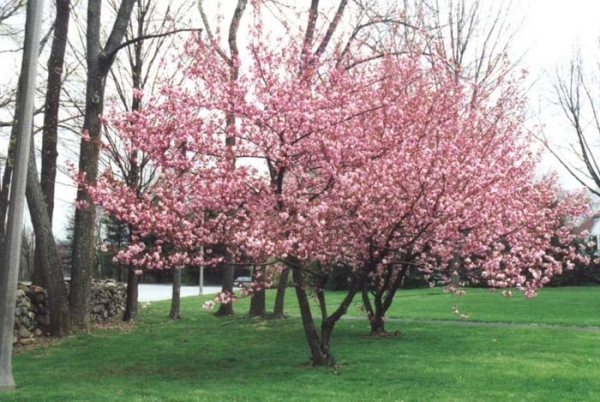
Planting and growing
For planting decorative sakura is necessary to pick up the illuminated and ventilated area without stagnant moisture during periods of floods and rains. The best choice will serve as a hill and elevation.
It is recommended to stop the choice on grafted seedlingswhich are traditionally purchased in the fall and aged to spring thaws in humid spaces at room temperature. Before planting, plants should have a height of about 1.5 meters, a mature trunk and a formed root network.
Planting preferably made in the late fall or early spring, before swelling of the kidneys, with a well-established warm temperature regime. Simultaneous planting of several seedlings provides in the future a greater degree of flowering abundance and fruit formation.
Plants should be planted at a distance of 1.5-2 m from each other and between-row space of 2.5-3 m.
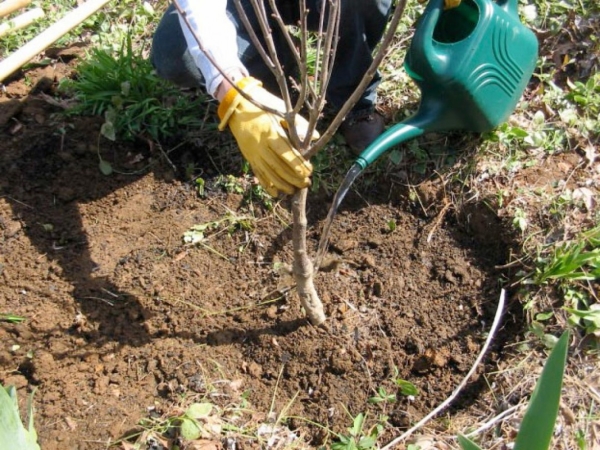
The holes for planting must be prepared in advance.. It is advisable to place in them a mixture of the upper fertile layers of earth and humus.
Immediately before planting it is necessary to fertilize the soil with 15-18 liters of potassium sulphate solution with the addition of superphosphates. Root neck sprinkled with earth can not.
At the end of the planting, the stalk zone is watered and gently mulched with humus or a thin peat layer of 4–5 cm.
At the initial stage of tree growth, care of the tree circle should be careful and careful. Damage to the root system and promptly remove weeds. In this case, Sakura strengthened faster and without harm perezimuet.
Peculiarities of care
Successful growth of sakura is possible with proper care. and creating optimal conditions for development. Systematic drainage and regular feeding contribute to the growth of a healthy tree.
Depletion of the soil is eliminated by adding humus and compost (6-8 kg) at each root. Chemical fertilization is carried out with a solution of the necessary elements at the rate of 15-18 g for one square meter of the forest zone.
A few plentiful irrigations of sakura are permissible at the stage of active growth. The rest of the time, it is sufficient to maintain the natural balance of soil moisture. Excessive hydration leads to a low degree of kidney formation., poor flowering and shredding petals.
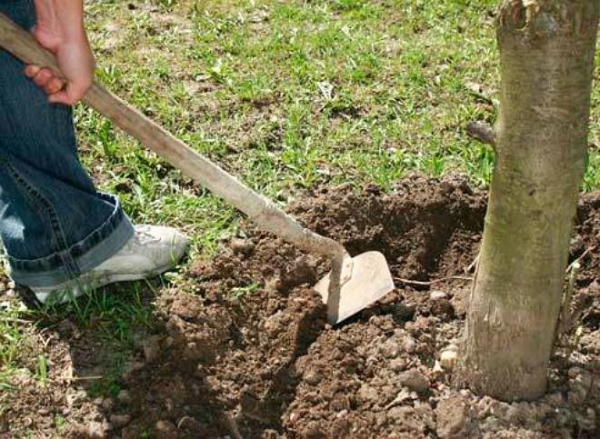
Before starting sap flow in early spring cutting of dry and damaged branches, thinning of the crown.
Adult plants are frost resistant, and young trees successfully winter in sheltered form. Before the beginning of the cold season, the sites of the scion, the stumps and the bases of the large branches are wrapped with agrofiber or scrap materials that do not create the greenhouse effect.
Throughout the vegetative season Sakura is sprayed with chemicals: primary - before flowering, secondary - after a month after the ovary of berries.
Pruning
Removal of affected and dried branchessprouts that impede comfortable light absorption and sufficient air exchange are carried out in early spring, before the start of sap flow.
Fragments with traces of activity of harmful organisms are subject to cutting and burning.
Cutting places should be treated with garden pitch.. It is important to ensure that gum does not form at the site of the cross sections. The appearance of adhesive growths is excluded in the case of proper drainage and irrigation.
Diseases and pests
If sakura is affected by harmful organisms, the flowering intensity decreases, the petals wrinkle, and the tree develops behind the norm. There may be evidence of stratification of the cortex and the formation of growths.
Unwanted neoplasms should be immediately removed and the localization of sections with healing agents should be removed.
You may be interested in the following publications:
A common ailment of Sakura, like other cherry trees, is defeat of the fungus, which leads to drying of the foliage, blackening and mummification of berries.
To help the plant in this unpleasant situation can spraying sulfur powder. It should cover the affected segments and prevent further spread of fungal aggression.
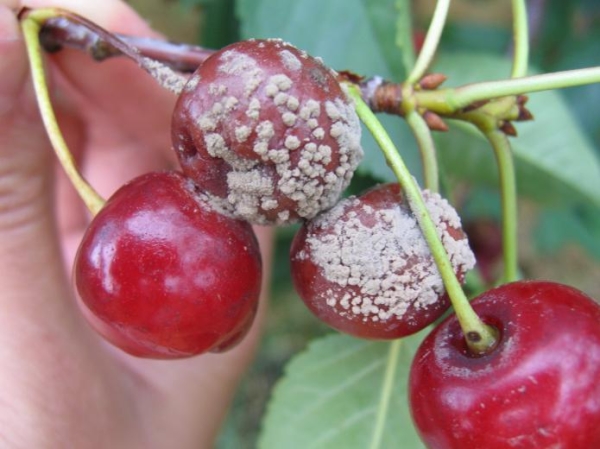
Foliage that falls from unhealthy sakurashould not be left under a tree for the winter. Healthy and infected leaves and branches to be taken out of the site and burn.
Such a precaution prevents the spread of fungal diseases to neighboring cultures.
The effect of combating harmful organic matter is enhanced by the use of insecticides. Restrictions on the use of chemicals are imposed. for the period of flowering and fruit set. In case of urgent need, this rule can be neglected.
The reward for his work is the contemplation of the unsurpassed aesthetic impact of a natural miracle. Worth trying: the guru of sakurovedeniya, Japanese, consider a person to be heartless if he is deaf to the manifestations of the surrounding beauties.
